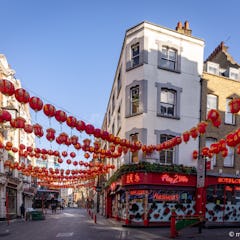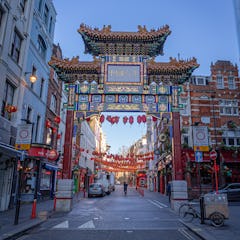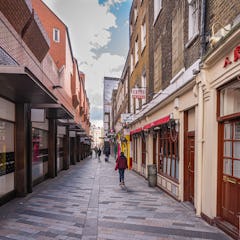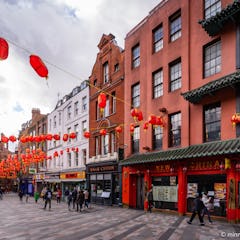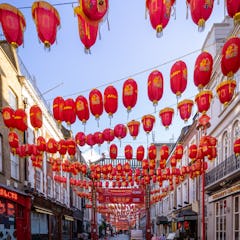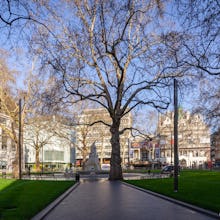History – From Limehouse to Gerrard Street
The roots of London’s Chinatown go back to the late 19th century, when the first Chinese community settled in the Limehouse docklands in the East End. There, Chinese sailors and immigrants established laundries, restaurants, and lodging houses, and the area became known as an exotic but marginalised part of London. Bombing during the Second World War and the relocation of dock activities diminished Limehouse’s significance. From the 1950s onward, Chinatown began to re-establish itself in London’s West End, particularly around Gerrard Street.
During the 1970s and 1980s, the number of Chinese restaurants in London increased rapidly, and Chinatown became a significant part of the city’s dining culture. Chinese and other East Asian cuisines gained visibility, and the area began to attract more locals and tourists. Today’s Chinatown is known not only for its Chinese but also for its Vietnamese, Korean, Malaysian, and Filipino food cultures. The area combines tradition, modern urban life, and commercial appeal.
Landmarks and Cultural Sites
Chinatown’s streets are always lively and colourful, and the buildings are decorated with ornate details and paper lanterns. The area gets often crowded, especially on weekends.
One of Chinatown’s main features is the striking Chinese gate on Wardour Street, completed in 2016. It was built in the Qing dynasty style in collaboration with Chinese craftsmen and British architects. The gate symbolises luck, protection, and hospitality, and its decorative elements – such as dragons and calligraphy carvings – welcome visitors to the area.
In addition to the gate, the area is rich in Chinese decorations, such as red lanterns hanging above the streets, especially during holidays, symbolising happiness and good fortune. The gate and many shops are also adorned with golden dragons, representing strength and protection.
There are several stone lions (shíshī) in the area, a thousand-year-old part of Chinese architectural tradition. The male lion symbolises the protection of the world, and the female lion symbolises the family. They are placed at building entrances to ward off evil spirits and bring good luck. Calligraphy scrolls and red lucky symbols also decorate doors and windows during festive periods.
Gerrard Street serves as the central street of Chinatown and is especially vibrant and colourful in the evenings. Newport Court, in turn, is known as Dessert Alley, a hub for sweet treats. Chinatown is also conveniently located near Leicester Square and Trafalgar Square, offering additional sights and cultural attractions. Leicester Square is renowned for its cinemas and film premieres, while Trafalgar Square is a historic square that features the National Gallery, offering world-class art experiences.
Restaurants and Cafés – A Culinary Journey Through Asia
Dining in Chinatown is a memorable part of any visit. Many restaurants offer delicious Asian food, such as dim sum, noodles, and dumplings – Chinese classics with variations found throughout East and Southeast Asia. There is also a wide range of cuisines from other Asian countries to suit different tastes. Restaurants can be bustling on weekends and in the evenings. The area also has many bars, cafés, and bubble tea shops for refreshments.
Little Korea is a Korean restaurant known for its authentic dishes and warm atmosphere. For those seeking quicker meals, the area offers a variety of takeaway options. ZhangLiang Malatang offers spicy Chinese hot pot dishes, where you can choose ingredients like noodles, meat, and vegetables according to your preference. Monga Fried Chicken specialises in thick, crispy Taiwanese chicken, while Good Friend Chicken is renowned for its quick, traditional Chinese dishes.
For those with a sweet tooth, Chinatown offers plenty of choices. Chinatown Bakery offers fresh pastries like pandan cake and filled buns. One of our favourites is Bubblewrap on Wardour Street, known for its fluffy waffles cooked to a crisp and filled with ice cream, sauces, and a variety of toppings. Many people take photos holding a waffle with the iconic Chinatown gate in the background. On nearby Newport Court, you’ll find Mamasons Dirty Ice Cream, a Filipino dessert shop best known for the Bilog, which is also our favourite. It’s a sweet fried bun filled with ice cream and often chocolate sauce or other fillings. The shop also serves tropical desserts like ube ice cream and halo-halo, showcasing the best of Filipino flavours. For bubble tea lovers, there are many options. HEYTEA brings a modern twist to the classic drink, Chatime offers a wide range of flavours, and Cuppacha is known for its colourful and visually striking drinks.
Food Shopping
Chinatown is an excellent place for food shopping. Various Chinese supermarkets offer a wide selection of products, meat, and seafood. The best known are Loon Fung Supermarket, which has been in business for over 50 years, and SeeWoo, opened in 1975. There is also New Loon Moon Supermarket, which is known for its fresh vegetables and noodles, and Oriental Delight, a smaller grocery shop that sells items such as dried seafood and spices. Chinatown’s supermarkets are full of tasty and inspiring finds for fans of Asian cuisine.
Events and Celebrations
Chinatown’s most famous celebration is the Chinese New Year, held in January or February, depending on the lunar calendar. The event fills the streets with parades, lion and dragon dances, music, martial arts performances, and fireworks. It is the largest Chinese New Year celebration in Europe, drawing thousands of visitors.
The Mid-Autumn Festival is an autumn family celebration when Chinatown is decorated with lanterns and traditional moon cakes are sold. Decorations and light installations adorn the streets, and some restaurants offer special menus to celebrate the occasion.
In summer, food festivals and pop-up events bring themed stalls, street food, workshops, and performers to the streets of Chinatown. Many restaurants take part in themed weeks or offer special dishes in honour of the events.
These events keep Chinatown lively year-round. During festive periods, the street decorations, performances, and unique atmosphere bring a special energy and celebratory spirit to the neighbourhood.
The Magic of Chinatown
Chinatown offers a chance to experience East and Southeast Asian cultures in the heart of London. The area’s restaurants, decorative architecture, and festive events create a vibrant atmosphere that attracts many visitors.
